How to set up screen off. Narrator to read text aloud
Narrator to read aloud the text, it touch control, keyboard control. Narrator tool helps the blind, visually impaired or simply having difficulty reading from the monitor. This feature reads text and other items on your screen aloud after you hover over, tap or click on them. And also reads text on panels, such as websites and warning windows messages... The readable item is highlighted in blue. This makes it easier for visually impaired people to keep track of what they read. Narrator is easiest to turn on by pressing Windows key, on the Start screen, then All Apps - Accessibility - Narrator.
In the settings of the announcer, it is possible to set it to start directly at the entrance to your system. For the convenience of controlling the speaker, there are a significant number of key combinations. A complete list of them can be displayed at any time by pressing the keyboard shortcut Caps lock+ F1. Most Narrator commands use the Caps Lock key, as it is rarely used for other purposes. While Narrator is running to write uppercase letters you must use the Shift key.
The undoubted improvement of the narrator in Windows 8.1 is the ability to slow down or speed up the speech of the narrator. In chapter " Speech», Narrator settings, there is a slider with which you can adjust the speech rate, by default set to 50 percent; voice volume, set to maximum by default; and the tone of voice is set at 50 percent. You can also select a Narrator voice. The commands for reading websites have been expanded to ensure that most elements on a web page are read aloud.
If you use a speaker on touch screen, to read the entire text, just slide your finger across the screen, to read a specific item, tap it. Additional tools are available for precise control of Narrator:
- Stop Narrator tap with one or two fingers
- read the entire current window; swipe with three fingers
- cry; double tap
- double click; triple tap
- show or hide Narrator; press with four fingers
- move to the next or previous item; swipe left or right
- dragging an element; tap with three fingers
- scroll the window; swipe up, down, left or right
- tab back and forth; swipe left or right with three fingers.
Additional controls are available to use Narrator on the website, such as the following phrases when you slide your finger up and down. Here's what they mean:
- heading, reads heading and highlights previous / next, swipe left / right.
- element, reads the element and highlights the previous or next on the page, swipe left / right.
- paragraph, reads a paragraph and highlights the previous or next, swipe left / right.
- line, reads a line and selects the previous or next line of text, swipe left / right.
- word, reads a word and highlights the previous or next word, swipe left / right.
- character, reads a character and highlights the previous or next character of the text, swipe left / right with your finger.
- table, reads the table and highlights the previous or next table on the website, swipe left / right.
- link, reads the link and highlights the previous or next link on the page, swipe left / right. Follow the link with a double tap.
Control Narrator from the keyboard.
If you are using Narrator with a keyboard, there are also controls for Narrator.
- clicking on the selected item; space or Enter
- moving the cursor across the screen; Tab + cursor keys
- read the paragraph; Caps Lock + D
- read the entire document; Caps Lock + H
- read the last item; Caps Lock + V
- read the whole window; Caps Lock + W
- go to the previous / next item; Caps Lock + cursor left or right
- volume control; Caps Lock + Page Up or Page Down
- read speed adjustment; Caps Lock + Plus (+) or Minus (-)
- enable or disable Caps Lock; quickly press Caps Lock twice
- stop reading; Ctrl
- Exit Narrator Caps Lock + Esc.
Narrator isn't just useful for the visually impaired. Tired of reading text on the screen? Turn on Narrator and continue working.
The operating system of the Windows family has been shipping for several years along with a decent set of standard programs, for example, MS Paint, Tweak UI, Calc, etc. Almost any program can be turned off, and Narrator is no exception.
Sponsored by the placement of P & G Articles on "How to Disable Narrator" How to Change the Screensaver on the Computer How to Enable the Virtual Keyboard How to Display the Keyboard on the Monitor
Instructions
In addition to the above-mentioned programs, Windows systems include those that act as additional assistants, for example, Narrator. Its task is to read out the text displayed on the screen or downloaded by you into the program through the clipboard. For complete shutdown this utility needs to run it, i.e. display on the screen, because the program works in background... On operating systems Windows versions Seven and Windows Vista, you need to click the "Start" menu and enter the command "Narrator" in the bottom search bar. In the search results, select "Narrator" or press the Enter key. In the window that opens, select the item "Control the launch of Narrator at logon" and uncheck the items "Enable Narrator" and "Enable Audio Description". To save the changes, click the "Apply" button. For older operating systems, this action can be performed through the Start menu. To do this, go to the "Standard Programs" section. In the Accessibility list, find Ease of Access Center and launch it. In the window that appears, go to the "Using a computer without a screen" block and uncheck the "Enable Narrator" item. After you restart your computer, you should be able to watch Narrator no longer launch. To check, start the Task Manager application and go to the Processes tab. If this process is still active, therefore, it is in the startup list. Press the Win + R keyboard shortcut and enter the msconfig command in the empty field. Click OK to launch the System Settings applet. Go to the Startup tab and uncheck the Narrator app option. To save the results and close the current window, click the "Apply" and "Restart" buttons. How simple
Other related news:
Language bar in operating systems of the Windows family, it is used to switch layouts by pressing the Ctrl + Shift or Alt + Shift key combination. But sometimes this panel disappears due to accidental deletion or system malfunction. You will need File Download Recovery
Most programs, including the operating system itself, produce automatic updates in the background, copying to HDD large file sizes. In some cases, this operation can delay the progress of other programs, so it can be disabled. You will need customization
To ensure high security of wired or wireless connections, you must enable authentication (authentication) support. With its help, it is possible to restrict access to your connection of other devices. You will need to work with the component
To find and eliminate the causes of problems, expressed in the appearance of error messages, you will need Windows startup Vista or Windows 7 using a minimal set of drivers and auto-loading programs, called a "clean start". Sponsored by P&G Posting Related Articles
Most likely, every user of the operating room Windows systems knows about the existence of key combinations and their purpose. Not all keyboard shortcuts are quick to press. The shortcuts of three keys are not very convenient to use. To make it easier to press 2 or more buttons at the same time, you can
While loading operating system some applications are launched, the shortcuts of which are in the startup list. You can add absolutely any application to this list. For some users, the news about the existence of such a list (startup file) will be very useful, since from
In operating systems of the Windows family there are software packages that are launched automatically, i.e. without user intervention. Some of them are in the startup list, they are quite easy to remove. Much harder to block automatic start programs that are not in
Why might you want to disable a feature called Narrator? Most, most likely, for the first time they hear that such a function is in the operating system. In principle, this function is disabled by default, but there are a number of different actions by which it could turn on, for example, it happened by accident, in some magical way, or the user, purely out of interest, turned on this function so that he could check what it is, and then forgot to turn it off back, and so on.
In general, as a result of these actions, after each start of the computer, a message may appear stating that you need to install an additional voice in accordance with the current system language. You can, of course, manually close it by simply clicking on "Close" and in the next program configuration window on "Exit", but over time it becomes very annoying. So let me show you how to disable system announcer so that he would no longer bother him in the future.
Disable Narrator on Windows 7
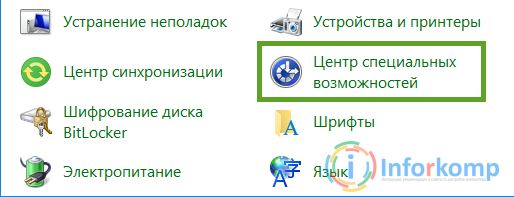
In general, this option to disable Narrator can be used absolutely in any operating system that was released by Microsoft.
But, that's not all, just as I'll show you how you can turn off Narrator in Windows 8.1, alternative way using quick settings.
Disable Narrator in Windows 8
So, hover the mouse pointer to any right corner and wait for the side panel to appear, on which we click on the image with the gear.


In the list of sections that opens, go to "".
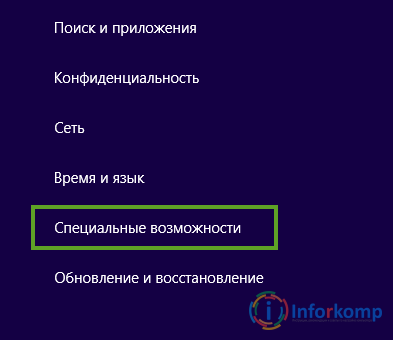
Well, there in the first line " Narrator". On the right, a menu of parameters will appear, in which, using the small switch, set the value “ Off».
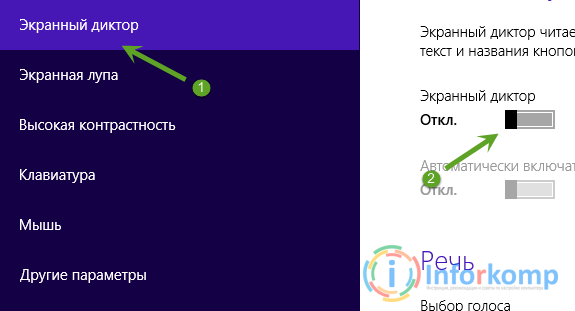
How to disable Narrator on Windows 10
In Windows 10, you can use both the first option with the control panel and the alternative, which is in part similar to the eight method.
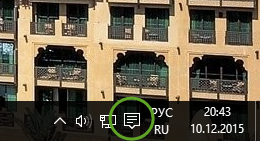
By the way, in the same window, if you use this function, you can change absolutely all of its settings.
Well, in principle, that's it, now you can choose either the first most universal method, or use one of the more modern menus that appeared only in Windows 8 and 10.
We continue to analyze special features on Windows computer 10. Today we will focus on the Narrator function. This function few people know and few people use it, simply because there is no special need for it. Narrator will voice all your actions on your computer. For example, if you select any shortcut on your desktop, that is, click on it, then Narrator will announce the name of the shortcut. Or, if you press the right arrow button, then Narrator will sound - "Right arrow". To open Narrator, in the lower-left corner of the screen, click the Start button. In the window that opens, click on the tab - All applications.
In the list of all applications, at the very bottom, find the tab Special abilities and open it. In the list that opens, click on the tab - Narrator.
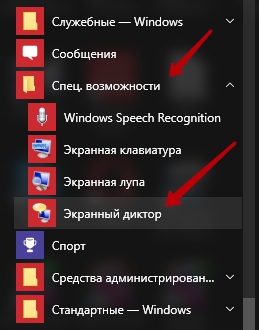
Next, you will have Narrator open. A window with a blue frame will appear on the screen. With the mouse cursor, you can select items on the screen that will be marked with a blue border and will be read by Narrator. Also, Narrator will follow all your actions on the computer and will voice them.
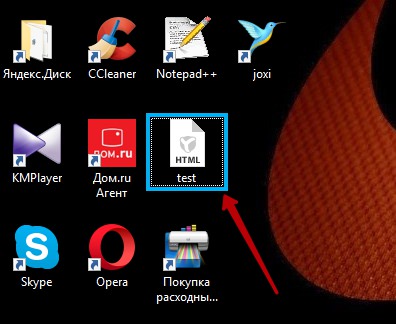
Narrator announces when you open a folder or file, enter text, and more. Here is such an interesting function that may be useful to someone. Narrator can be used for a variety of purposes, such as dubbing video or audio files. In general, you can think of something, the main thing is to experiment!
 How to put a melody (ringtone) on a call for ZTE Blade M, L4, V956, v815w Download ringtones zte
How to put a melody (ringtone) on a call for ZTE Blade M, L4, V956, v815w Download ringtones zte How to put a melody (ringtone) on a call for ZTE Blade M, L4, V956, v815w Phone zte 320 how to set a melody
How to put a melody (ringtone) on a call for ZTE Blade M, L4, V956, v815w Phone zte 320 how to set a melody How to hard reset on LG Optimus L5 and similar Lji androids
How to hard reset on LG Optimus L5 and similar Lji androids